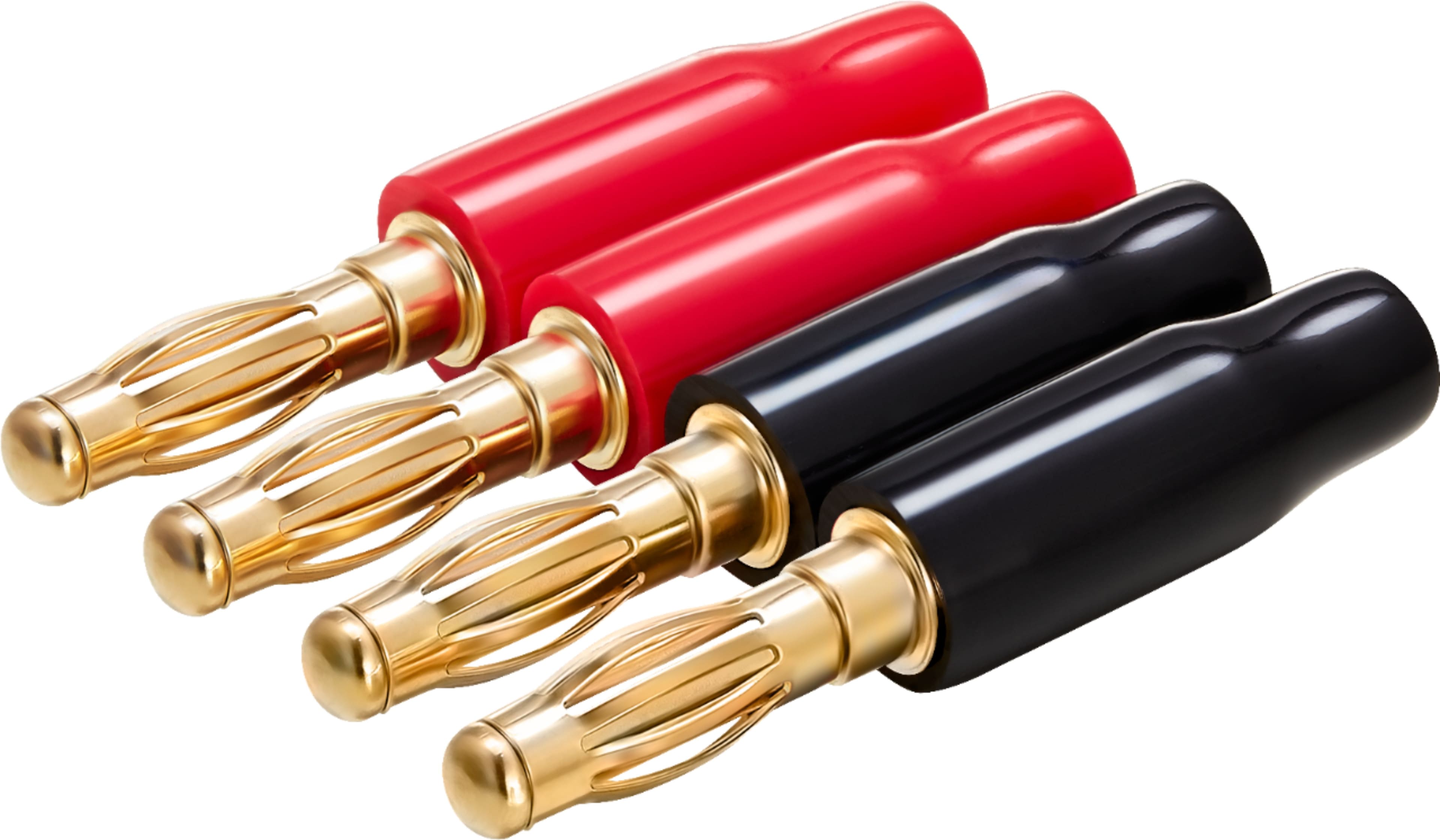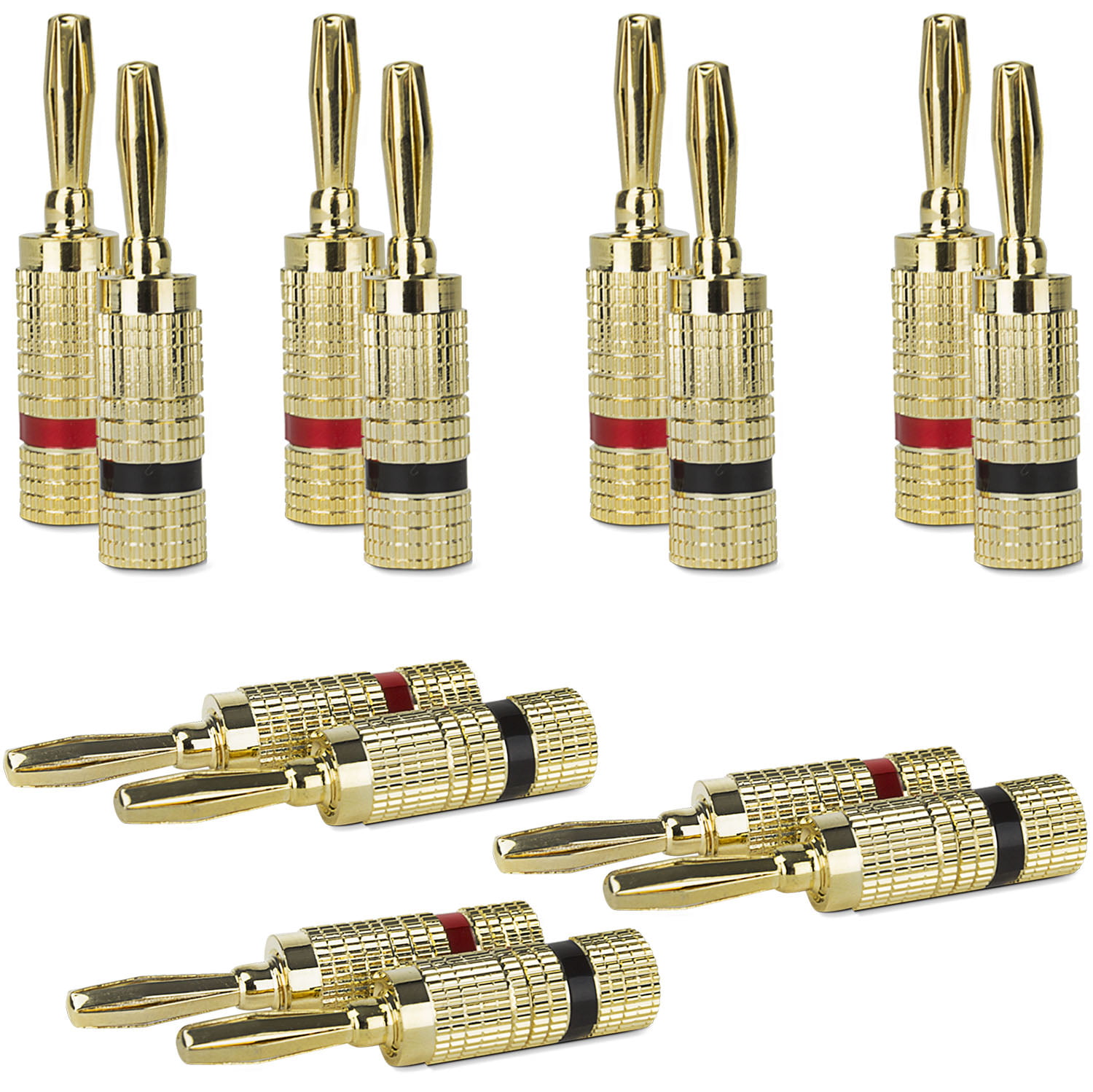Unveiling the best speaker wire with banana plugs, a crucial component in any audiophile’s arsenal. Discover the transformative power of these specialized wires, meticulously engineered to deliver pristine sound quality. Delve into the intricacies of banana plugs, wire gauge, shielding, and more, as we guide you towards an unparalleled auditory journey.
From discerning enthusiasts to seasoned audio professionals, this comprehensive guide empowers you with the knowledge to make informed decisions. Whether you seek to enhance your home theater system or elevate your studio setup, our insights will lead you to the perfect speaker wire with banana plugs, ensuring an exceptional listening experience.
Understanding Banana Plugs

Banana plugs are connectors used on the ends of speaker wire, allowing for a secure and easy connection to speaker terminals. They offer several advantages over bare wire:
- Convenience:Banana plugs make it easy to connect and disconnect speaker wires, especially in tight spaces.
- Security:The spring-loaded contacts of banana plugs provide a secure connection that won’t come loose.
- Protection:Banana plugs protect the exposed ends of speaker wire from corrosion and damage.
Types of Banana Plugs
There are two main types of banana plugs:
- Single Banana Plugs:These plugs have a single contact point, suitable for standard speaker terminals.
- Dual Banana Plugs:These plugs have two contact points, allowing for bi-wiring or connecting to dual binding posts.
Additionally, some banana plugs feature locking mechanisms that prevent accidental disconnection.
Wire Gauge and Materials
The wire gauge and materials used in speaker wire significantly impact the overall performance of your audio system. Understanding these factors will help you make informed choices when selecting speaker wire for your specific needs.
Wire Gauge
Wire gauge refers to the thickness of the wire, with a lower gauge number indicating a thicker wire. Thicker wires have less resistance, which allows them to carry electrical signals more efficiently. This reduces signal loss and ensures that your speakers receive a clean, undistorted signal.
- 14-16 AWG:Suitable for most home audio applications, providing a good balance between performance and cost.
- 12-14 AWG:Recommended for longer wire runs or high-power systems, offering reduced signal loss.
- 10-12 AWG:Ideal for high-end systems or demanding applications, providing minimal signal loss and enhanced sound quality.
Wire Materials
The material used in speaker wire also affects its performance. Here are some common materials and their characteristics:
- Copper:The most common and affordable option, offering good conductivity and durability.
- Silver:More expensive than copper but provides better conductivity, resulting in improved sound quality.
- Gold:Resistant to corrosion and provides excellent conductivity, making it suitable for high-end applications.
- Alloys:Combinations of different metals, such as copper and silver, can offer a balance of conductivity, durability, and cost.
| Wire Gauge | Signal Loss (per 100ft) | Suitable Applications |
|---|---|---|
| 10 AWG | 0.1dB | High-end systems, demanding applications |
| 12 AWG | 0.2dB | Long wire runs, high-power systems |
| 14 AWG | 0.4dB | Most home audio applications |
| 16 AWG | 0.8dB | Short wire runs, low-power systems |
Speaker Wire Construction

Speaker wire construction refers to the physical structure and design of the wire. It plays a crucial role in determining the sound quality, flexibility, and durability of the wire.
There are two main types of speaker wire constructions: stranded and solid core.
Stranded Wire
Stranded wire consists of multiple smaller strands of wire twisted together to form a single conductor. This construction offers several advantages:
- Flexibility:Stranded wire is highly flexible, making it easier to route and bend around obstacles during installation.
- Reduced Skin Effect:The multiple strands distribute the current more evenly, reducing the skin effect (a phenomenon where high-frequency signals travel primarily on the outer surface of the conductor) and improving sound quality.
However, stranded wire also has some drawbacks:
- Increased Resistance:The increased surface area of stranded wire leads to higher resistance compared to solid core wire, which can result in power loss over longer distances.
- Potential for Corrosion:The gaps between the strands can trap moisture and oxygen, increasing the risk of corrosion over time.
Solid Core Wire
Solid core wire consists of a single, solid strand of metal. This construction offers the following advantages:
- Lower Resistance:Solid core wire has a lower resistance than stranded wire, resulting in less power loss and improved sound quality.
- Increased Durability:The solid construction makes the wire more resistant to damage from bending or stretching.
However, solid core wire also has some disadvantages:
- Less Flexibility:Solid core wire is less flexible than stranded wire, making it more difficult to route and bend during installation.
- Increased Skin Effect:The solid core construction concentrates the current flow on the outer surface, increasing the skin effect and potentially affecting sound quality at higher frequencies.
Recommendation
The best speaker wire construction for different applications depends on specific requirements:
- For short runs and flexible installations:Stranded wire is the preferred choice due to its flexibility and reduced skin effect.
- For long runs and high-power applications:Solid core wire is recommended for its lower resistance and improved durability.
- For applications requiring a balance of flexibility and performance:Hybrid speaker wires that combine stranded and solid core conductors offer a compromise between the two construction types.
Shielding and Noise Reduction
Shielding in speaker wire is crucial to prevent electromagnetic interference (EMI) and radio frequency interference (RFI) from distorting the audio signal. EMI and RFI can originate from nearby electronic devices, power lines, or other sources, causing audible noise, distortion, or hum in the speakers.
Shielding materials are typically incorporated into the speaker wire’s construction to mitigate these unwanted signals. Two common types of shielding include:
Foil Shielding
- Thin, metallic foil wrapped around the insulated conductors
- Provides effective protection against EMI and RFI
- Can be susceptible to tearing or puncture
Braid Shielding
- Woven mesh of thin, metallic strands surrounding the conductors
- Offers excellent flexibility and durability
- Provides superior shielding effectiveness compared to foil shielding
The effectiveness of different shielding materials in reducing noise and interference varies depending on their conductivity, thickness, and construction. A thicker or more conductive shielding material will generally provide better protection against EMI and RFI.
Enhance your audio experience with replacement ear pads for Sony WH1000XM4 over-ear headphones. Crafted from premium materials, these ear pads provide superior comfort and noise isolation, allowing you to fully immerse yourself in your music or audiobooks.
| Shielding Material | Effectiveness |
|---|---|
| Foil | Good |
| Braid | Excellent |
Speaker Wire Length and Impedance
The length of speaker wire used in a system can affect the overall impedance of the system. Impedance is a measure of the resistance to the flow of alternating current (AC), and it is measured in ohms (Ω). The higher the impedance, the more difficult it is for the current to flow.
In a speaker system, the impedance of the wire is important because it can affect the amount of power that is delivered to the speakers.
Calculating Impedance
The impedance of a speaker wire is determined by its length, gauge, and material. The following formula can be used to calculate the impedance of a speaker wire:
Z = (2
L) / A
Where:
- Z is the impedance in ohms (Ω)
- L is the length of the wire in feet
- A is the cross-sectional area of the wire in circular mils (CM)
The cross-sectional area of a wire can be found using the following formula:
A = π
For an immersive virtual reality experience, the Meta Quest 3 VR headset offers cutting-edge technology and high-resolution visuals. Its lightweight design and intuitive controls make it perfect for both gaming and exploring virtual worlds.
(d/2)^2
Where:
- A is the cross-sectional area in circular mils (CM)
- d is the diameter of the wire in inches
The following table provides the cross-sectional area and impedance per 100 feet of common speaker wire gauges:
| Gauge | Cross-sectional Area (CM) | Impedance (Ω) |
|---|---|---|
| 10 | 10,380 | 0.05 |
| 12 | 6,530 | 0.08 |
| 14 | 4,110 | 0.12 |
| 16 | 2,580 | 0.19 |
| 18 | 1,620 | 0.31 |
Impact of Impedance on Sound Quality
The impedance of a speaker wire can affect the sound quality of a system. A wire with too high of an impedance can cause the sound to be muffled or distorted. A wire with too low of an impedance can cause the sound to be too bright or harsh.
Recommendations for Optimal Speaker Wire Length
The optimal speaker wire length will vary depending on the specific system. However, the following general guidelines can be followed:
- For short runs (less than 10 feet), use a wire with a gauge of 16 AWG or larger.
- For medium runs (10-25 feet), use a wire with a gauge of 14 AWG or larger.
- For long runs (over 25 feet), use a wire with a gauge of 12 AWG or larger.
Durability and Aesthetics: Best Speaker Wire With Banana Plugs
The durability of speaker wire is essential for ensuring its longevity and performance. Several factors influence the durability of speaker wire, including the insulation, jacket material, and construction.
Insulation and Jacket Material, Best speaker wire with banana plugs
The insulation of speaker wire protects the conductors from short circuits and other damage. High-quality insulation materials, such as polyethylene (PE) and polyvinyl chloride (PVC), provide excellent protection against moisture, heat, and abrasion.
The jacket material, which covers the insulation, also plays a crucial role in durability. Durable jacket materials, such as nylon and polyethylene terephthalate (PET), can withstand wear and tear, preventing damage to the wire.
Construction
The construction of speaker wire affects its flexibility and durability. Stranded wire, which consists of multiple strands of copper, is more flexible and less prone to breakage than solid-core wire.
Additionally, the number of strands in a speaker wire affects its durability. A higher number of strands provides greater flexibility and reduces the risk of breakage.
Protection from Damage
To protect speaker wire from damage, it is important to handle it carefully and avoid exposing it to excessive stress or heat. Additionally, using cable ties or conduit can help organize and protect the wire from damage.
Aesthetics
Speaker wire is available in a variety of aesthetic designs and finishes to complement different home décor styles. Some speaker wires feature colored jackets or transparent insulation, allowing you to match the wire to your speakers or room décor.
Other speaker wires have a more industrial look, with rugged jackets and exposed conductors. These wires are ideal for use in exposed areas, such as behind wall-mounted speakers.
Conclusion

In conclusion, selecting the best speaker wire with banana plugs is a journey that demands careful consideration. By understanding the nuances of banana plugs, wire gauge, shielding, and construction, you can unlock the full potential of your audio system. Embrace the transformative power of these specialized wires and immerse yourself in a world of pure, unadulterated sound.
Frequently Asked Questions
What are the benefits of using banana plugs on speaker wire?
Banana plugs provide a secure and convenient connection between speaker wire and audio equipment, reducing signal loss and ensuring optimal sound quality.
What is the optimal wire gauge for speaker wire?
The ideal wire gauge depends on the length of the wire run and the impedance of your speakers. Generally, 14-gauge wire is suitable for most applications.
What type of shielding is most effective in reducing noise and interference?
Braided shielding provides superior protection against electromagnetic interference compared to foil shielding, ensuring a cleaner, more accurate sound.